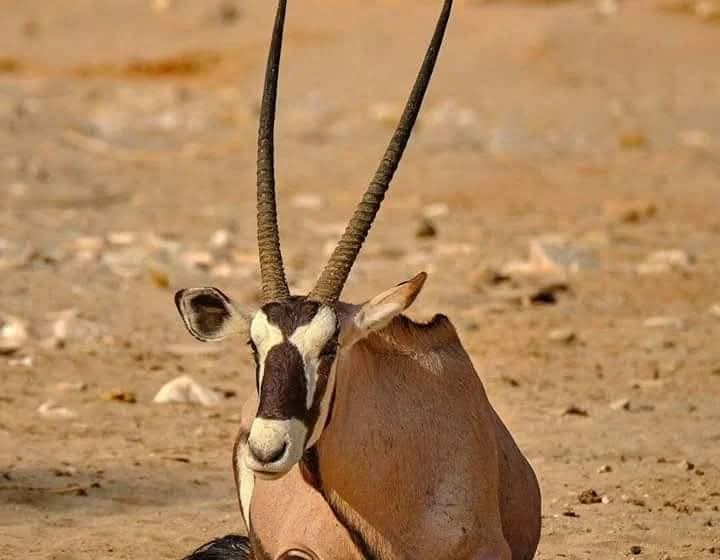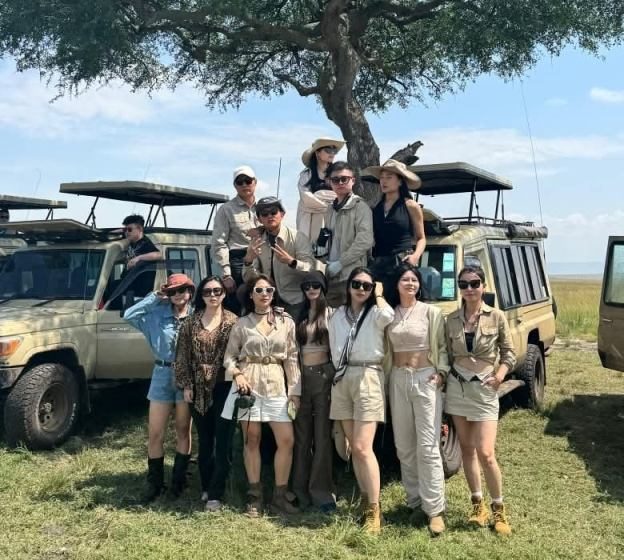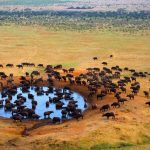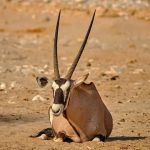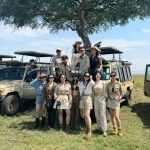Kenya’s Southern Circuit is one of the most varied and rewarding safari circuits found in the country. It stretches from the base of Mount Kilimanjaro to the coastal flats close to Mombasa; the Southern Circuit is a mixture of wildlife, scenery, and history all rolled into one.
Most travelers go directly north to the Masai Mara, where they miss out on another part of Kenya: one that is quieter, wilder, and full of nature’s beauty. The Southern Circuit takes you from the elephant herds of Amboseli to the rocky, volcanic plains of Tsavo West, and into the vast savannahs of Tsavo East. This makes for an exhilarating journey through untamed Africa.
Lost for safari ideas? We guarantee that you will find great wildlife photography, rare wildlife, or adventure; the Southern Circuit is sure to deliver. We hope to highlight the reasons why the Southern Circuit is one of the best safari circuits in East Africa.
Amboseli National Park – The Land of Giants
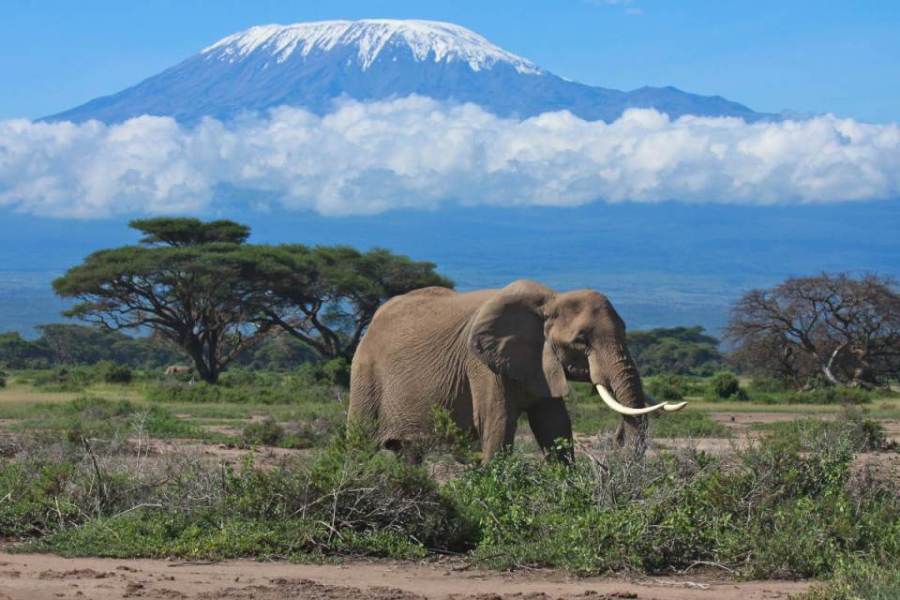
Typically, tours of the Southern Circuit of Kenya usually begin with a visit to Amboseli National Park at the foothills of the iconic Mountain Kilimanjaro on the border with Tanzania. Amboseli is particularly well-known for its enormous herds of elephants and unforgettable views of the snow-capped summit of Kilimanjaro — the highest mountain in Africa.
Amboseli is derived from a Maasai word meaning “salty dust,” which describes the park’s dusty, dry lake bed and plains that convert into shallow lakes in the rainy season. The Maasai named it after observing the way the dust and salt combine to form a shimmering surface, much like silver, on the plains.
Wildlife and Scenery
Amboseli is a dream for photographers. Elephants move majestically across Amboseli’s plains in view of Kilimanjaro, at times creating stunning silhouettes as the elephants roam the park. Amboseli is also home to lions, cheetahs, hyenas, buffaloes, zebras, wildebeest, and over 400 bird species.
During the dry season, wildlife gathers around the waterlogged areas that receive underground water from Kilimanjaro’s melting ice. As such, it is one of the best locations to get close to wildlife in Kenya.
Top Things to Do
- Game Drives: Early mornings and evenings are conducive times to get out and observe wildlife activity.
- Observation Hill: For impressive views of Amboseli National Park and Mt. Kilimanjaro, climb to the top of this low hill.
- Cultural Visits: Visit nearby Maasai villages to learn more about the traditions of the Maasai people who live among wildlife.
Amboseli is also easily combined with nearby Tsavo East and Tsavo West, making for a perfect Southern Circuit safari itinerary.
Tsavo West National Park – The Wild Heart of the South
Tsavo West National Park is the next attractive stop along the circuit from Amboseli, offering perhaps Kenya’s most stunning and dramatic landscape. Almost 9,000 square kilometers in area, Tsavo West is a combination of volcanic landscape, hilly terrain, and lush oases.

The Land of History and Mystery
One of the exciting things about Tsavo West is its history. In 1898, two lions brought terror to railway building workers near the Tsavo River during the Kenya-Uganda Railway. These two lions would go on to be known as the “Man-Eaters of Tsavo,” known for their attacks and killing of Railway workers. Their story has taken on a legendary status through the years as it truly exemplified the untamed wilderness feel of Tsavo.
The Tsavo River flows through both Tsavo East and Tsavo West, and is the main water supply for a large number of animals that can be found in both game parks. The old railway, which became world famous during the man-eater attacks, runs part of the way along this river through Tsavo East. Today, this railway line trails along the river, providing history for travelers who are retracing some of Kenya’s colonial history.
Unique Volcanic Scenery
The scenery of the park is unlike almost any other point in Kenya. Volcanic hills, lava flows, and craters make for a rugged, ancient landscape. One very striking feature is the Shetani Lava Flow, a large dark rocky scar in the park formed hundreds of years ago from volcanic eruptions. In Swahili, “Shetani” means “devil,” since local people believed the fiery lava was the work of evil spirits.
When visitors explore this area further, they will also find the Chaimu Crater, where they can walk to the top of the crater and be rewarded with breathtaking views over the plains and lava formations in the park.
Mzima Springs – The Life Source
Mzima Springs is another one of the treats within Tsavo West and is comprised of clear pools fed by underground streams from the Chyulu Hills. The springs provide water for the park, as well as Mombasa, the coastal city.
Here, visitors can look through underwater views of hippos, crocodiles, and fish—a rare and serene experience in the middle of the wilderness.
In southern Tsavo West is Lake Jipe, which sits on the borderline of Kenya and Tanzania. Lake Jipe provides a key habitat for hippos, waterbirds, and fish, and offers peaceful boat excursions featuring stunning views of the Pare Mountains just across the border.
Scenic Viewing Points and Rhino Conservation
Two well-known viewing points are Poacher’s Lookout and Roaring Rocks, which allow visitors sweeping views across the park and its landscape. These high points make for some spectacular photographs and sundowners.
The Ngulia Rhino Sanctuary is an area of the park where endangered black rhinos are protected within a fenced-in area. Seeing these rare creatures in their natural habitat is a once-in-a-lifetime experience for safari enthusiasts.
Wildlife Viewing
The dense vegetation within Tsavo West can make various animals harder to spot, but for the patient traveler, there are rewarding scenes of elephants, leopards, buffalo, giraffes, zebras, and a wide variety of birds.
Tsavo West is varied enough that you can have some great wildlife sightings, but also spectacular natural beauty.
Tsavo East National Park – The Great Red Wilderness
Divided from Tsavo West by the Nairobi-Mombasa motorway, Tsavo East National Park has a greater area, drier conditions, and more open features. It is known for its extensive herds of red elephants, which have taken on this color due to red volcanic dust coating their skin.

The Open Savannah
Tsavo East is about 13,700 square kilometers in size and is one of the largest parks in Kenya. It has broad plains filled with baobab trees, which stretch to the horizon. The Galana River runs through the park to provide water to the animals and soften the landscape.
A major landmark of interest in the area is the Yatta Plateau, often cited as the longest lava flow in the world at around 300 km. It formed millions of years ago through the ancient historical volcanic activity of the Ol Doinyo Sabuk volcano. The plateau runs parallel to the Athi River, offering stunning panoramic views of the park. This geological wonder, along with some of Kenya’s most underrated attractions, should be included in your must-see list for travelers who enjoy nature or the history of the natural environment.
Tsavo East is also home to Mudanda Rock, a gigantic, whale-back rock formation, which serves as a natural water catchment area, drawing elephants, buffalo, and other wildlife to the area during the dry season. It is one of the most recognizable viewing areas in the park.
In the preceding centuries, Tsavo East likewise experienced poaching activities, when some Akamba merchants traded ivory with Arab traders along the coast prior to conservation laws. Today, the Kenya Wildlife Service works vigorously to protect the park’s wildlife and eliminate poaching.
Wildlife in Tsavo East
The park has elephants, lions, leopards, cheetahs, buffalo, giraffes, zebras, hippos, crocodiles, and numerous types of antelope. It is also a birdwatcher’s paradise with more than 500 species observed, as well as the golden-breasted starling and Somali ostrich.
Must-Visit Attractions
Sites to see include the Aruba Dam, a human-made dam with many animals visiting the dam for water, especially in the dry seasons, and the Lugard Falls, which consists of stunning rapids on the Galana River, where visitors can watch crocodiles basking on rocks. The Mudal Bird Pools are a perfect area for visitors who appreciate birds and photography.
The Adventure Spirit
Tsavo East is more isolated and wild than virtually all parks in Kenya, which adds to the true sense of adventure and solitude with its enormous size. It is also easy to combine Tsavo East with Tsavo West for the full Southern Circuit experience of the heart of wild Africa.
Taita Hills and Tsavo West – A Unique Safari Stay
Located immediately south of Tsavo West is the Taita Hills Wildlife Sanctuary, a stunning but small reserve within the Southern Circuit. It is home to the Salt Lick Safari Lodge, a well-known Safari Lodge in Kenya.
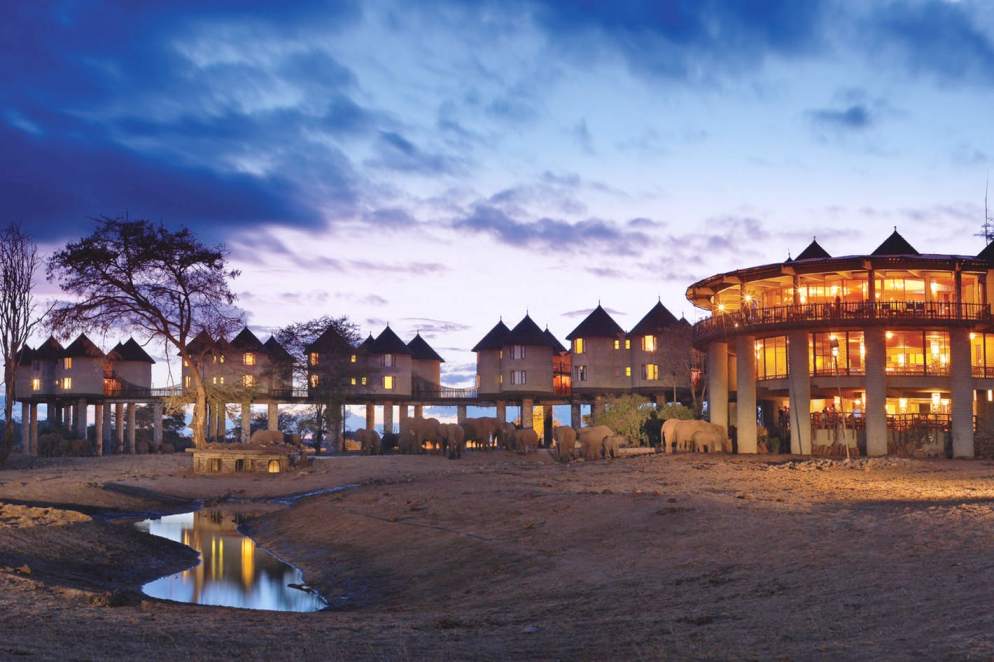
A Lodge with a Story
The Salt Lick Lodge is famous for its unique architecture, consisting of circular rooms on stilts above salt licks and waterholes. You can watch elephants, buffalo, and other animals as they come down to drink water and lick the mineral-rich soil from either your room or the viewing decks.
German History at the Salt Lick
Few visitors realize that the Taita Hills region was part of World War I. The area saw fighting between German and British forces, leaving some military history behind which visitors to the area may still explore today. The guides at the lodge like to provide visitors with interesting stories of the time, which adds a historical dimension to the safari.
The vicinity of Salt Lick Lodge also contains remnants of German history that date back to World War I, when skirmishes between German and British soldiers occurred in the Taita Hills. The remnants of bunkers and stories are an interesting historical element to your visit.
Wildlife and Scenic Views
While Taita Hills is smaller than Tsavo, it delivers fantastic wildlife viewing. You are likely to see elephants, lions, leopards, antelopes, and a plethora of bird species. There are also some night game drives available, so you can see the nocturnal action.
If you are a traveler looking for some comfort, history, and nature, Salt Lick Lodge is a must-stop on Kenya’s Southern Circuit.
Mombasa and the Mystery of Low-Gravity Flow
Following your trip to Tsavo and Taita Hills, many vacationers arrive at the coast of Kenya. When you have a long journey from Tsavo West or Taita Hills to Mombasa, it is one of the most interesting trips you might take, when driving from dry savannahs to lush tropical scenery.
In your journey, you will also come upon many of the more mysterious areas of natural phenomena in the country, the low-gravity area close to Mombasa. Here you will find vehicles in neutral rolling uphill rather than rolling downhill. Scientists will tell you that this is just a simple optical illusion of the visual landscape around you. And the locals will share elaborate stories and mysteries from legend only adds to the intrigue.
Mombasa helps to recharge after your safari. White-sand beaches, Swahili culture, and amazing historical sites — being, for example, Fort Jesus to close your Southern Circuit journey.
Beyond Mombasa – History, Culture, and the Coastal Experience
Mombasa is more than a gateway to Kenya’s beaches; it is a living museum of East African history. Founded over a thousand years ago, the island city was once a major trading post between Arabs, Persians, Indians, and Africans who came along the Swahili Coast to trade things such as gold, ivory, and spices. The blending of these cultures created the unique Swahili language and coastal architecture now seen in Old Town Mombasa: narrow streets, carved wooden doors, and brightly colored coral stone buildings.

Fort Jesus was built by the Portuguese in 1593. The fort is a symbol of the turbulent past that Mombasa experienced. Over the centuries, the fort changed hands between the Portuguese, Arabs, and British, leaving layers of history and culture. Today, it is a UNESCO World Heritage Site that tells the story of the centuries of trade, conflict, and coexistence that occurred in the Indian Ocean.
Mombasa is a great destination for travelers to choose between enjoyment and exploration of the past. The beaches of Nyali, Bamburi, and Shanzu, on the other hand, are known for their swimming, diving, and snorkeling opportunities in the warm turquoise waters of the Indian Ocean; the beaches also offer local spice markets, a dhow cruise, and Swahili foods like fish curry in coconut milk or pilau.
Diani Beach, located further south, is arguably one of the most beautiful and famous African beaches, with its long stretches of powdery white sand beach and clear water, lined with palm trees on the Indian Ocean. Diani Beach is also a sporting paradise for adventure travelers — guests can choose from sky diving, deep-sea fishing, kitesurfing, or dolphin watching excursions. For those simply seeking zen, Diani Beach offers its calmness and luxury resorts as a great escape after an adventurous safari on the Southern Circuit.
The Coastal Connection
Going from Tsavo’s savannahs to the coast is a memorable journey that moves from the wilderness of elephants and lava flows to the coastal breeze and sense of history.
Besides discovering Kenya’s remarkable wildlife, the journey also highlights the multicultural aspect of the country — from Amboseli’s Maasai to Mombasa’s Swahili, each experience along the Southern Circuit and beyond showcases how all people, wildlife, and landscapes have collaborated to create a culture.
Visitors will often choose to end their private Kenya safaris at the coast, where they can enjoy the beautiful ocean culture and relaxation before traveling home. Whether it is wandering around the historic streets of Mombasa, the sunset over Diani, or simply listening to the sound of the ocean waves, the Kenyan Coast reflects the Southern Circuit experience with tranquility, culture, and beauty.
Connecting the Southern Circuit
The Southern Circuit’s uniqueness revolves around its seamlessly connected destinations. You can simply drive five hours from Nairobi to Amboseli National Park. After Amboseli, it takes about two hours to get to Tsavo West and about three hours to go from Tsavo West to Tsavo East around the highway that separates the two parks. After you have driven around the huge landscapes of Tsavo for the day, you have the option of continuing for an additional hour to Taita Hills and Salt Lick Lodge, or even driving on to the coast. It takes about three to four hours from Taita Hills to reach Mombasa.
This road provides travelers with flexibility — short 5-day safaris or the longer, more private example of a safari in Kenya that includes all the highlights of the Southern wilderness.
Best Time to Visit Kenya’s Southern Circuit
The Southern Circuit may be visited at any time of the year; however, the dry times, which are from June to October and January to February, are best for animal viewing. In the dry times, animals will congregate around water sources, and the roads are more easily traversed.
From November to December and from March to May is the green season, which brings green scenery, birds that migrate through, and fewer visitors. This is a wonderful time for photographers and visitors who prefer a quieter safari experience.
Safari Experiences and Accommodation
Every park and reserve on the Southern Circuit has accommodation choices across the entire spectrum – budget camps through to high-end lodges. In Amboseli, you will find eco-lodges or tented camps with fantastic views of Mount Kilimanjaro. Tsavo West has rustic safari lodges near Mzima Springs and Chaimu Crater, while Tsavo East features remote camps along the Galana River. Salt Lick Lodge, additionally, is unique in having raised viewing lookouts as part of its structure.
A private Kenya safari will provide the flexibility to explore the Southern Circuit at your own pace, as will a guided group tour or possibly a camping safari if sleeping in the bush is something you would enjoy.
Highlights of Kenya’s Southern Circuit
The Southern Circuit is filled with incredible locations. Amboseli National Park is famous for its massive elephants and spectacular views of Mount Kilimanjaro. Tsavo West National Park offers volcanic scenery and ancient lava flows, such as the Shetani Lava Flow, along with attractions such as Mzima Springs, Ngulia Rhino Sanctuary, Poacher’s Lookout, and Roaring Rocks.
Tsavo East National Park captivates visitors with its incredible open plains, its red elephants, and the incredible Lugard Falls on the Galana River. Also, Taita Hills and Salt Lick Lodge offer a comfortable stay and glimpses of history with the stories of the German war in the area.
To finish the circuit, Mombasa offers visitors the strange low-gravity flow, which is an optical illusion of the highest order and mesmerizes every visitor to this day.
Why Explore the Southern Circuit
In contrast to the busy parks of the north, the Southern Circuit offers peace and authenticity. You will traverse great distances, taking in spectacular scenery, and experience the wild side of Kenya without the crowds.
Here adventure meets culture, history, and natural wonders — from the haunting tale of the Man-Eaters of Tsavo to the serene waters of Mzima Springs. Be it Shetani Lava Flows, the delightful hike up the Chaimu Crater, or resting for a night at Salt Lick Lodge the every minute will reveal something different about Kenya.
And when you do get to the coast, watching the ocean waves after your days in the bush is truly mesmerizing – a perfect finish to a wonderfully incredible safari.
Final Thoughts
The Southern Circuit of Kenya presents a hidden jewel that embodies Africa in its complexity. It is a journey through two worlds of experience, from the ski slopes of Marunga to the volcanic plains of Tsavo; from the ancient flows of the Great Rift Valley in Amboseli to the springs of Kiboko; from the wild savannas of Tanzania to the tropical beaches in the Indian Ocean.
Whether it is a private Kenya safari or a guided experience, the Southern Circuit will provide you with experiences beyond wildlife; it is a journey through history, geology, and culture, and every stop will tell a story.
This route from Amboseli through Tsavo, Salt Lick Lodge, and the mysterious low gravity flow in Mombasa, encapsulates the southern beauty of Kenya.
So, pack your camera, your sense of wonder, and discover Kenya’s Southern Circuit where nature, history, and adventure intersect.


